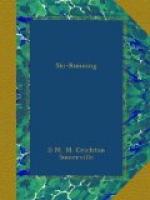Good makers, such as Bjornsted in Bern or Staub at Zurich, may be trusted to make their Skis right proportionately, and the buyer need not worry about their width or depth so long as the length is right. There is a great deal of difference in the line of a Ski, as there is in a boat. Flat ones are ugly compared with those which hump along the centre, but they are also lighter. It seems to me wise for the beginner to hire his first Skis, rather than to buy them. Most of the sports shops in the different centres are very obliging and will allow their clients to try two or three pairs of Skis in order to experience the difference between them.
They should not curve up too abruptly in front and they should be about one inch apart in the centre when laid flat one against the other. This spring adds greatly to the comfort of running and should be maintained by the Ski having a block of wood between them when put away for the Summer or even when laid by for two or three days.
The question of binding is a very serious one. Broadly there are three different types:
(1) Toe bindings, by which only the toe
of the
boot is attached to the Ski.
(2) Solid binding with a sole attached
to the
Ski.
(3) Leather heel bindings.
(1) I have tried two forms of toe bindings—the B.B. and the B.B.B. and gave them up for the following reasons. Firstly, I think it a dangerous binding. There is practically no give at all so that in a bad fall when the foot is twisted under one, if the Ski does not move the leg has to give way and may be broken. I think surgeons agree that there are more accidents as a result of wearing a B.B. binding than any other—so that it seems to me much better to start with another type of binding and then go into the B.B. later if preferred. Another drawback is that as the whole pivotal pressure in a turn is borne by the toe iron, when a B.B. binding is worn, the toe irons are always being forced open. Not only that, but the spring on the Ski which holds the hook on the boot is so strong that it tends to pull the boot through the toe irons, so that gradually the boot gets longer and more pointed and the spring no longer holds.
All this criticism may be due to prejudice on my part, but I have tried the B.B. with enthusiasm and only gave it up because I was convinced that a heel binding was more satisfactory. Since I tried it, two or three new forms of toe binding have been put on the market, the simplest of which seems to me to be the Davos form, which is merely a strap fixed to the Ski with an iron loop at the end to fit into the hook on the boot and an ordinary Huitfeldt spring buckle to fix it firmly.




